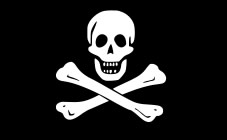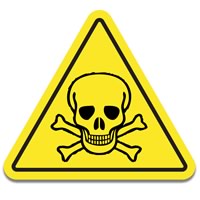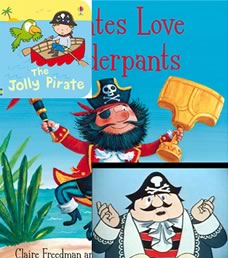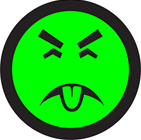 The skull and crossbones.
There’s a good argument that this is one of the most successful graphic designs in the last 1,000 years. Perhaps that’s why it seems to be laughing. Aside from religious iconography, there aren’t too many symbols that have remained in common usage for 500+ years.
From the middle ages skulls and crosses were inked next to deceased crew members names on ship manifests.
Of course, by the 1700’s — as the ‘Jolly Roger‘ — we saw the symbol used on pirate flags. The flag was intended to intimidate victims into surrendering their ship with as little fight as possible.
The skull and crossbones.
There’s a good argument that this is one of the most successful graphic designs in the last 1,000 years. Perhaps that’s why it seems to be laughing. Aside from religious iconography, there aren’t too many symbols that have remained in common usage for 500+ years.
From the middle ages skulls and crosses were inked next to deceased crew members names on ship manifests.
Of course, by the 1700’s — as the ‘Jolly Roger‘ — we saw the symbol used on pirate flags. The flag was intended to intimidate victims into surrendering their ship with as little fight as possible.
 From around 1850, the skull came to be used to label ‘poison’. At that time, the convention was also to use blue, ridged glass on poison bottles — but that fell out of favor in the 1900s.
Today, it even has a unicode symbol – ‘☠ – HTML ☠’
Generally when designing a symbol like this, your task is to:
From around 1850, the skull came to be used to label ‘poison’. At that time, the convention was also to use blue, ridged glass on poison bottles — but that fell out of favor in the 1900s.
Today, it even has a unicode symbol – ‘☠ – HTML ☠’
Generally when designing a symbol like this, your task is to:
- Keep it simple: Your symbol may need be reproduced at small scale and in poorly lit environments.
- Avoid written language: Even if your user is literate, it may not be in your selected language.
- Avoid reliance on culture: A good symbol shouldn’t rely heavily on previous knowledge, fairytales, folklore, history, science or other special learning.
 When does a child first understand exactly what a skull is? Sure, they might know it’s a face of sorts, but would they comprehend that they are looking at bones — and what that implies? At 3 years old? Maybe 5? It must vary.
What’s more important is how culture has accidently softened the symbol’s meaning. Take a look around any toy store — even the toys and books for toddlers abound with fun and friendly pirates, almost always emblazoned with jolly rogers.
It wouldn’t be crazy for a child to conclude that any bottle labelled with the jolly roger indicated that the contents were recommended for drinking while dancing a jig or sword fighting.
Not an ideal result.
When does a child first understand exactly what a skull is? Sure, they might know it’s a face of sorts, but would they comprehend that they are looking at bones — and what that implies? At 3 years old? Maybe 5? It must vary.
What’s more important is how culture has accidently softened the symbol’s meaning. Take a look around any toy store — even the toys and books for toddlers abound with fun and friendly pirates, almost always emblazoned with jolly rogers.
It wouldn’t be crazy for a child to conclude that any bottle labelled with the jolly roger indicated that the contents were recommended for drinking while dancing a jig or sword fighting.
Not an ideal result.
The Alternative?
 So, is there a better symbol for marking poisons? Perhaps there has been.
In the 1970’s Dr. Richard Moriaty came up with this — ‘Mr. Yuk‘ — as a new poison labeller. As a Pittsburgh Pirates fan, Moriaty found that far from a deterrent, pirate imagery was in fact well-loved by his patients, both young and old.
Moriaty’s alternative symbol used a ‘yucky’ green face, squinting eyes and a stuck-out tongue to communicate the idea of a nasty flavor.
Any kid who ever spat out a brussel sprout knows what this means — perhaps before they can even talk. Humans are social animals and we’re born with advanced face-interpreting software. Moriaty’s child-like icon taps into that innate ability.
So, why don’t we see Mr. Yuk everywhere now?
Although the Mr. Yuk icon gained some mindshare at the time, the design is currently still owned, trademarked and copyrighted by Moriaty’s employer — The Children’s Hospital of Pittsburgh of UPMC. Unlike the skull and crossbones (public domain), you can’t use Mr. Yuk on your poison bottle without the explicit permission of the hospital.
We’re stuck with the pirate flag for now. At least be thankful that — for all their plundering, blood-thirsty violence, bad language and poor hygiene — pirates were never fierce defenders of their trademarks.
So, is there a better symbol for marking poisons? Perhaps there has been.
In the 1970’s Dr. Richard Moriaty came up with this — ‘Mr. Yuk‘ — as a new poison labeller. As a Pittsburgh Pirates fan, Moriaty found that far from a deterrent, pirate imagery was in fact well-loved by his patients, both young and old.
Moriaty’s alternative symbol used a ‘yucky’ green face, squinting eyes and a stuck-out tongue to communicate the idea of a nasty flavor.
Any kid who ever spat out a brussel sprout knows what this means — perhaps before they can even talk. Humans are social animals and we’re born with advanced face-interpreting software. Moriaty’s child-like icon taps into that innate ability.
So, why don’t we see Mr. Yuk everywhere now?
Although the Mr. Yuk icon gained some mindshare at the time, the design is currently still owned, trademarked and copyrighted by Moriaty’s employer — The Children’s Hospital of Pittsburgh of UPMC. Unlike the skull and crossbones (public domain), you can’t use Mr. Yuk on your poison bottle without the explicit permission of the hospital.
We’re stuck with the pirate flag for now. At least be thankful that — for all their plundering, blood-thirsty violence, bad language and poor hygiene — pirates were never fierce defenders of their trademarks.
Frequently Asked Questions about Mr. Yuk and Poison Pirates
Who is Mr. Yuk and why is he associated with poison?
Mr. Yuk is a trademarked graphic image, created by the Children’s Hospital of Pittsburgh, and widely employed in the United States as a warning symbol that a substance is poisonous. The image is a green, grimacing face, which is meant to depict sickness and disgust, and is often used on labels to discourage children from ingesting hazardous substances.
What is the history behind the creation of Mr. Yuk?
The Mr. Yuk symbol was created in 1971 by pediatrician Dr. Richard Moriarty, who felt that the traditional skull and crossbones symbol, often associated with pirates, was no longer effective in deterring children from consuming poisonous substances. He believed that children found the skull and crossbones symbol appealing due to its association with adventure and excitement.
How effective is Mr. Yuk in preventing poisonings?
The effectiveness of Mr. Yuk has been a subject of debate. Some studies suggest that the symbol does deter children from ingesting harmful substances, while others argue that it may not be universally understood or recognized. However, the widespread use of the symbol indicates its general effectiveness as a deterrent.
How is the skull and crossbones symbol related to poison?
The skull and crossbones symbol has a long history of being associated with danger and death. It was often used by pirates on their flags, which is why it is sometimes referred to as the “pirate symbol”. In the context of poison, the symbol is used to indicate that a substance is lethal if ingested or inhaled.
Why was there a need to replace the skull and crossbones symbol with Mr. Yuk?
The skull and crossbones symbol, due to its association with pirates and adventure, was found to be appealing to children, which defeated its purpose as a warning symbol. This led to the creation of Mr. Yuk, a symbol designed to evoke a sense of disgust and sickness, and thus deter children from ingesting harmful substances.
Where is the Mr. Yuk symbol commonly used?
The Mr. Yuk symbol is commonly used on the packaging of household chemicals, medications, and other potentially harmful substances. It is also used in educational materials about poison prevention.
How can I get Mr. Yuk stickers for my home?
Mr. Yuk stickers can be obtained from various sources, including the American Association of Poison Control Centers and some local health departments. They can also be purchased online.
What should I do if I see the Mr. Yuk symbol on a product?
If you see the Mr. Yuk symbol on a product, it means that the product is potentially harmful or poisonous if ingested. Keep the product out of reach of children and pets, and follow the manufacturer’s instructions for safe use and storage.
Are there other symbols similar to Mr. Yuk used to indicate poison?
Yes, there are other symbols used to indicate poison, including the skull and crossbones symbol and the ISO circle. However, Mr. Yuk is the most widely recognized symbol in the United States.
What should I do if someone ingests a substance marked with the Mr. Yuk symbol?
If someone ingests a substance marked with the Mr. Yuk symbol, seek immediate medical attention. Contact your local poison control center or dial 911. Try to have the product container or packaging available to provide information about the ingested substance.
 Alex Walker
Alex WalkerAlex has been doing cruel and unusual things to CSS since 2001. He is the lead front-end design and dev for SitePoint and one-time SitePoint's Design and UX editor with over 150+ newsletter written. Co-author of The Principles of Beautiful Web Design. Now Alex is involved in the planning, development, production, and marketing of a huge range of printed and online products and references. He has designed over 60+ of SitePoint's book covers.


